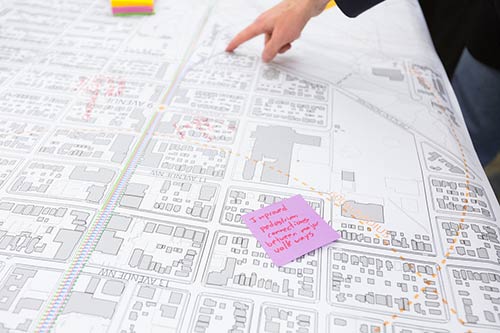City Planning & Policy plan and budget
Our goal is to build a resilient city of attractive, inclusive and equitable communities that meet the various lifestyle choices of Calgarians, and employment areas that support diversity in our economy. We engage with Calgarians and the development industry to develop the long-range vision for the city, and multi-community local area plans that reflect the goals of individual communities. While looking to our future, we align equity, growth funding, and investment considerations with the regeneration of our environment and continuing economic prosperity.
Our customers
- All Calgarians
- Business owners
- Industry members and investors
- Other City departments
- Council
Our partners
- Calgarians
- Community associations
- Heritage Calgary
- Building Industry and Land Development Association
- NAIOP Commercial Real Estate Development Association
- Inner-City Builders' Association
- Business Improvement Areas
- Business owners
Value to Calgarians
- helps inform Council decisions
- community development
- new community planning
- preservation of heritage buildings
- improves housing equity
- advances sustainability in Calgary
What we deliver
- Planning recommendations to Council to implement the Municipal Development Plan and Calgary Transportation Plan.
- Engagement with Calgarians, industry and Council.
- Best professional practices that balance the interests of diverse groups for optimal mutual outcomes.
Budget breakdown
Operating and capital budgets explained
The budgets you see here are expenditures net of recoveries.
The City develops two budgets to create impact aligned with Council’s Strategic Direction:
- The four-year (2023-2026) operating plans and budgets
- The five-year (2023-2027+) capital plans and budgets
The operating budget includes revenues, recoveries and spending related to ongoing operations. These include:
- Salaries, wages and benefits.
- Day to day programs, maintenance and services.
- Administration costs (e.g., insurance).
- Fuel
- Utilities
- Capital financing costs.
The City's total net operating budget is zero. This means we budget to collect the revenue needed to deliver services to Calgarians — no more, no less. We collect this revenue through property taxes and other sources.
The capital budget pays for long-lived assets. These provide the foundation for the services Calgarians rely on. They include:
- Maintenance of current infrastructure (e.g., bridges, buildings and playgrounds).
- Upgrades to existing community infrastructure.
- New infrastructure to provide services in areas that are underserved (e.g., Green Line).
- New infrastructure for growing areas of the city.
Learn more about our 2023-2026 Service Plans and Budgets.
See how the budget has been adjusted since November 2022
Measuring performance
We are measuring our performance in five areas. Each value is the goal we expect to reach by 2026.

What we've heard
Major topics that have emerged in recent years include the need to:
- Address climate change and the climate emergency.
- Revitalize our downtown.
- Provide affordable housing choices for all Calgarians.
- Address diversity, equity, inclusion, and belonging in the design and growth of our communities.
- Facilitate the journey toward Indigenous reconciliation through purposeful action.
- Diversify our economy, invest in and fund growth in a fiscally sustainable manner.
- Address concerns that redevelopment is changing the character of communities.
- Provide a clear, predictable, user-friendly planning system.
These topics are often connected and must be comprehensively addressed for Calgary to continue to be a competitive city of choice and continue to rank as one of the most livable cities, attracting new residents and businesses as a great place to make a living and a great place to make a life.
Participate and view results of City researchWhat we're watching
Our service sets the foundation for the wide range of activities Calgarians are engaged in every day. City planning holistically and proactively considers the demographic, cultural, and economic changes that influence the city’s development and works towards giving Calgarians the choices they expect. External influences and trends that may impact the service include, but are not limited to, social, economic, and environmental challenges and changes. These influences and our increasingly diverse population demand strategies and plans that enhance Calgary’s resilience.

Our initiatives
What we plan to do
Our vision is twofold: First, deliver strategies, plans and tools to implement Council's focus areas of downtown revitalization, social equity, and land use and local area planning. Secondly, and equally critical is taking action on the climate emergency through land use and transportation policies.
How we're going to get there
- Continue to rank as one of the most livable, attractive, and successful cities in the world, by aligning and combining the Municipal Development Plan and the Calgary Transportation Plan into one user-friendly document, The Calgary Plan. This new policy will enable us to effectively address the climate emergency, social equity, diversity, inclusion, belonging, anti-racism, and Truth and Reconciliation.
- Revitalize Calgary’s downtown by investing in (1) major civic projects to support trade, tourism, job creation and building strong regional economies; and (2) priority public infrastructure projects to provide necessary public amenity for a thriving community and that complement developer investment.
- Diversify the mix of uses and increase housing opportunities in the downtown core to attract new residents and increase vibrancy in the heart of our city by implementing the Downtown Calgary Development Incentive Program, which, offers financial incentives to building owners to convert surplus office space into non-office uses and homes for Calgarians.
- Deliver the residential, commercial and industrial opportunities that will continue to make Calgary one of the world's most livable and attractive cities by renewing the Land Use Bylaw to implement the vision of the Municipal Development Plan more effectively, while removing barriers from desired development and business activities.

